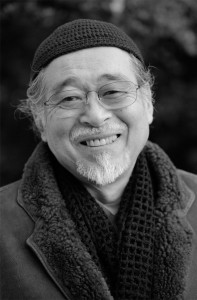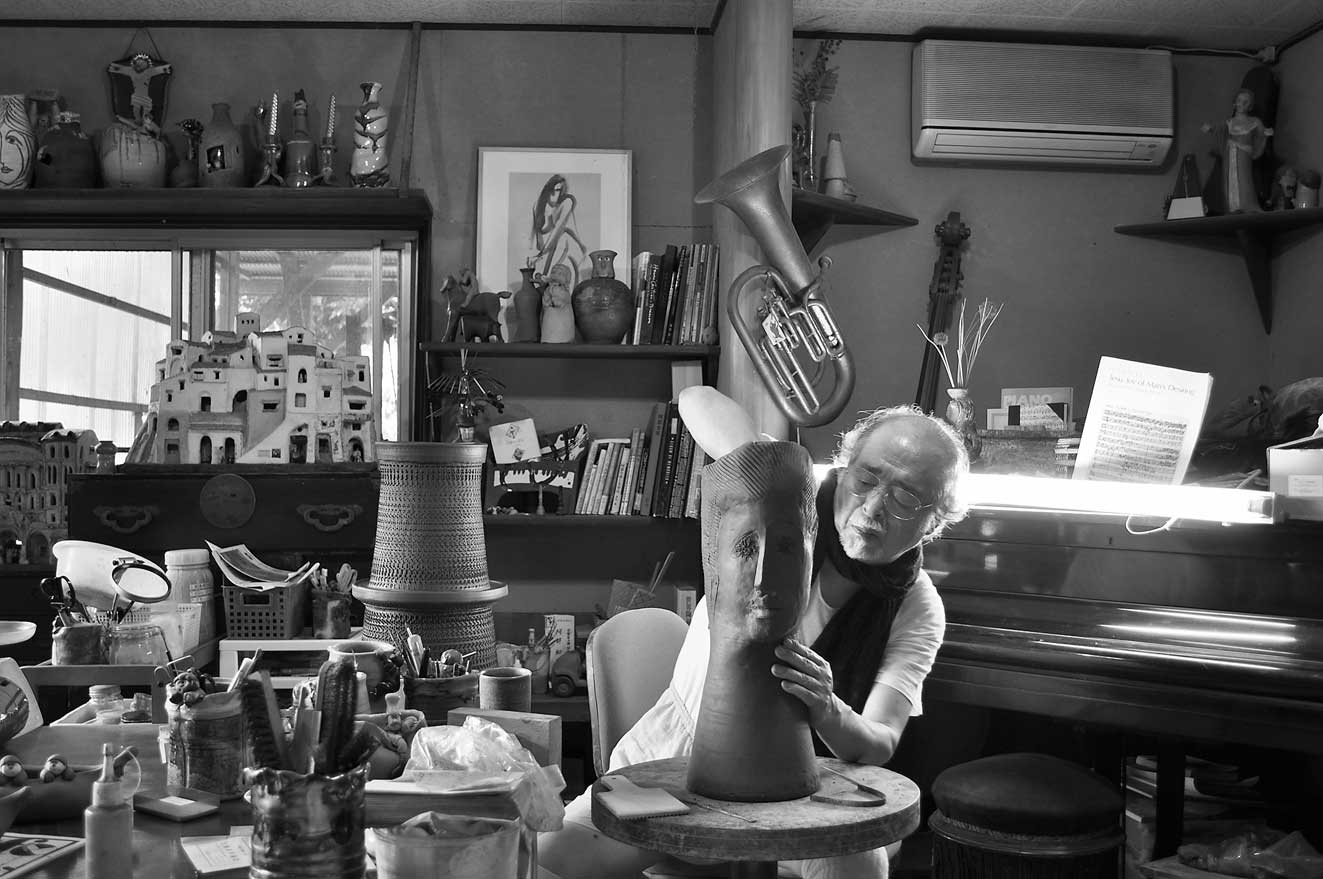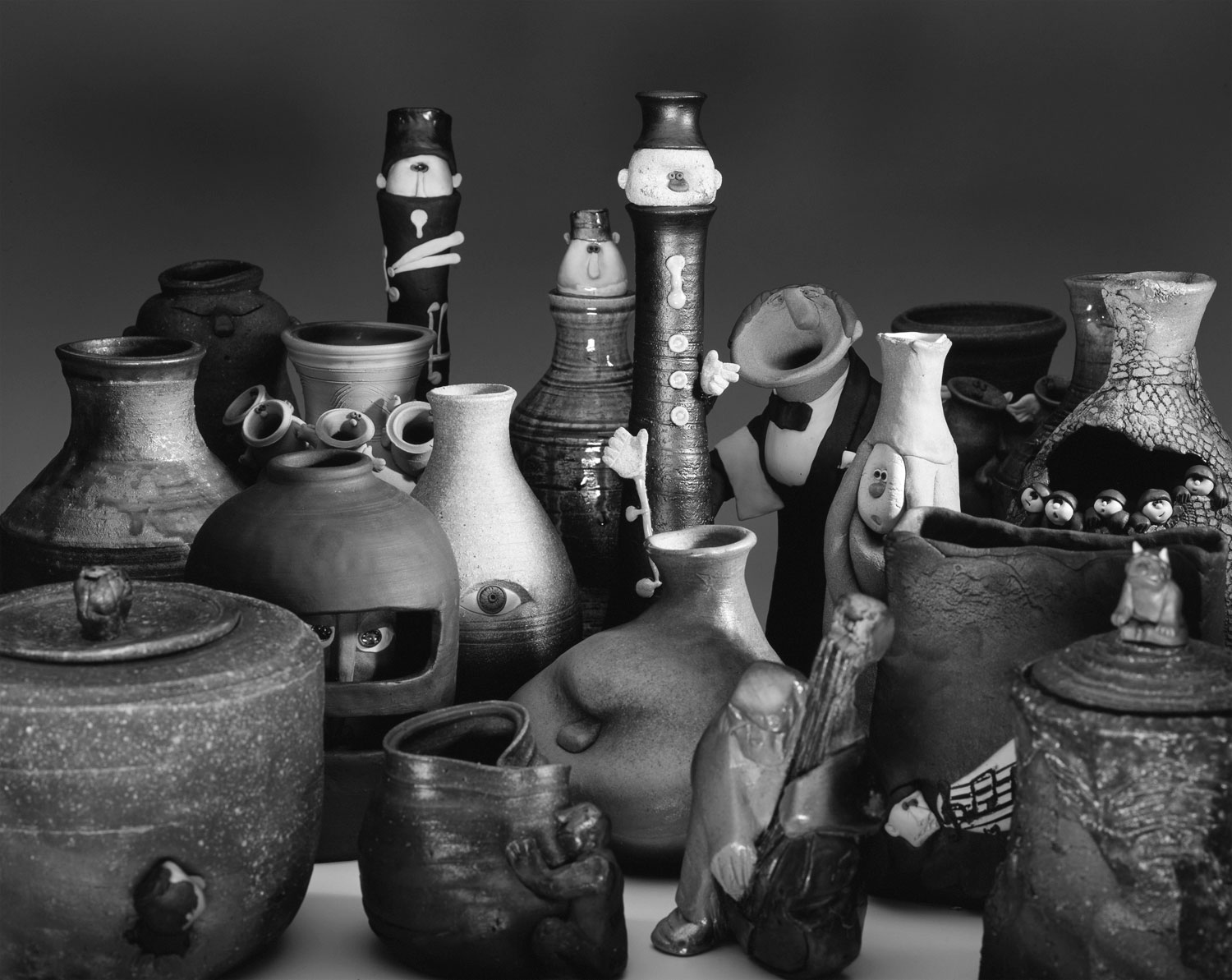
Wato Abe
Born in 1937 in Suginami, Tokyo, as the oldest son of Gosei Abe (painter) and Nao Abe (doll artist and cooking specialist). He was tutored in painting and sculpture by his father and doll making by his mother. His father’s workshop was a frequent gathering spot for the likes of Osamu Dazai, Gaishi Yamagishi, Kazuo Dan, and Katsuichiro Kamei, and he was raised in an environment surrounded by poets, art students, musicians and other such lodgers. At age three, he was given a lump of oil-based sculpting clay by his father. This awakened him to creating things, and since that day he has continued to do so in lieu of even eating and sleeping. As a junior high school student, he entered contests as a general applicant and continued to be awarded high honors. For a time, he was an aspiring musician and journeyed as a wanderer, but he ultimately devoted himself to clay sculpture, and has continued to this day.
Career
| 1952 | Special Award: Sankei Shimbun Doll Exhibition |
| 1953 | Special Award: Sankei Shimbun Doll Exhibition |
| 1955 | Studied under Yoshiaki Yasuhara, Counselor of the Japan Fine Arts Exhibition (Nitten) |
| 1956 | Silver Medal: Asia Olympic Exhibition |
| 1960 | Special Award: Asahi Shimbun Modern Doll Exhibition |
| 1962 | Special Award: Asahi Shimbun Modern Doll Exhibition |
| 1964 | Asahi Prize: Asahi Shimbun Modern Doll Exhibition |
| 1965 | Solo Exhibition at Ueno Matsuzakaya |
| 1966 | Judged in Asahi Shimbun Modern Doll Exhibition |
| 1967 | Solo Exhibition at Ueno Matsuzakaya First Time Honorable Mention: Japan Traditional Arts and Crafts New Work Exhibition |
| 1968 | Solo Exhibition at Yokohama Nozawaya Solo Exhibition at Shinjuku Keio Department Store Solo Exhibition (Spring and Fall) at Nihonbashi Takashimaya Solo Exhibition at Kyoto Takashimaya |
| 1969 | Solo Exhibition (Spring and Fall) at Nihonbashi Takashimaya Solo Exhibition at Yokohama Nozawaya Solo Exhibition at Nihonbashi Shimomura Gallery (Held annually every year until 1972) Constructed a Kiln on the Tateshina Plateau, Nagano Prefecture |
| 1970 | Solo Exhibition (Spring and Fall) at Nihonbashi Takashimaya Solo Exhibition at Nihonbashi Maruzen |
| 1971 | Solo Exhibition at Nihonbashi Mitsukoshi Headquarters |
| 1973 | Moved Kiln to Usami, Ito City |
| 1974 | Solo Exhibition at Imperial Hotel (Spring and Fall) First Time Award: Japan Traditional Arts and Crafts Exhibition Solo Exhibitions in Aomori City, Hirosaki City, and Hachinohe City, hosted by Aomori RAB Television Solo Exhibition at Nihonbashi Mitsukoshi Headquarters |
| 1975 | Solo Exhibition at Yokohama Takashimaya Solo Exhibition at Imperial Hotel (Spring and Fall) Solo Exhibition in Sapporo Maruzen Honorable Mention: Japan Traditional Arts and Crafts New Work Exhibition |
| 1976 | Solo Exhibition at Imperial Hotel (Spring and Fall) Solo Exhibition at Aomori RAB Television Gallery |
| 1977 | Solo Exhibition at Aoyama Yoshino Gallery Solo Exhibition at Nihonbashi Mitsukoshi Headquarters Became Full Member of Japan Traditional Arts and Crafts |
| 1978 | Solo Exhibition at Nagoya Hana Gallery (Held every other year thereafter) Solo Exhibition at Ginza Matsuya Asobi Gallery |
| 1979 | Solo Exhibition at Ginza La Pola |
| 1980 | Solo Exhibition at Ginza Matsuya Asobi Gallery |
| 1981 | Solo Exhibition at Shinjuku Keio Department Store |
| 1982 | Solo Exhibition at Nihonbashi Mitsukoshi Headquarters |
| 1983 | Solo Exhibition at Tokyo Yaesu Gallery Exhibited at the All-Japan Traditional Arts and Crafts Select Writers’ Exhibition |
| 1984 | Exhibited at the All-Japan Traditional Arts and Crafts Select Writers’ Exhibition Solo Exhibition at Osaka Wako Solo Exhibition at Ginza Matsuya Asobi Gallery Solo Exhibition at Shinjuku Keio Department Store Solo Exhibition at Osaka Matsuzakaya Solo Exhibition at Shinjuku Washington Hotel |
| 1987 | Solo Exhibition at Nihonbashi Mitsukoshi Headquarters |
| 1988 | Solo Exhibition at Matsuyama Hakubi Tosono |
| 1989 | Solo Exhibition at Nihonbashi Mitsukoshi Headquarters Withdrew from the Japan Craft World (Japan Traditional Arts and Crafts Exhibition), and worked independently thereafter Solo Exhibition at Aomori Matsukiya |
| 1990 | Solo Exhibition with Chamber Music at TKC Salon |
| 1991 | Solo Exhibition at Nihonbashi Mitsukoshi Headquarters Solo Exhibition at Masuda Studio Solo Exhibition at Gifu Takashimaya |
| 1992 | Exhibited at Japanese Modern Art Masterpiece Exhibition in Barcelona Solo Exhibition with Chamber Music at TKC Salon Solo Exhibition at Aomori Citizens’ Museum |
| 1993 | Solo Exhibition at Nihonbashi Mitsukoshi Headquarters Wato Abe Permanent Gallery Opened at Dokaten, Izu Plateau Solo Exhibition at Kanazawa INAX Gallery |
| 1994 | Solo Exhibition at Kurashiki Mitsukoshi |
| 1995 | Solo Exhibition at Nihonbashi Mitsukoshi Headquarters Solo Exhibition at Aomori Citizens’ Museum Solo Exhibition at Saga Kamiizumido Gallery |
| 2010 | Solo Exhibition at Nihonbashi Mitsukoshi Headquarters |
| 2014 | Solo Exhibition, Paris France |

Photo by Kayoko Abe
Dear Wato
It was 30 years ago that I was first introduced to Wato by his mother, Nao Abe. I thought, “What a strange name!” Wato. Wa (“Japan”) and To (“China”). The country of Japan and the country of China. I suppose you could just as easily say “Sino-Japan”. From antiquity, the countries of Japan and China have had a deep cultural connection. However, in 1937, when Wato was born into this world, war had broken out between Japan and China. Bestowing such a name on their child under those circumstances is a tribute to the depth and magnitude of the parents’ thoughts. As his name implies, Wato is a man whose depths cannot be seen no matter how hard you try, and a man who does not know fear. I don’t know if it is because of this or despite it, but sometimes you can see him writhing in frustration and demonstrating to those around him a stubbornness that will not bend in any way. At that time, Wato had a robust energy, with the heart and curiosity of a child. He left the panic surrounding him to engross himself in something in an instant, his heart rushing along at a moment’s notice. Each surprised “Wha-?” was followed by a muttered “Oh, I see,” relieving the ordinary people around him for the time being.
On the other hand, he was big-hearted, yet fragile and delicate like fine glasswork, at times requiring quite careful handling. At age three, he was given oil clay by his painter father, with which he made things, only to destroy them, and then make them again. He listened to the sound of the wind, looked over the appearance of things, eyed the elaborate details of life, and then shaped them out of clay. He sharpened his mind, and artwork flowed from his fingertips. But they disappear when destroyed. I wonder if in his child’s heart he felt joy and transience, and the joy that reemerges after transience. He was clearly different than the people doing nothing more than making balls of rounded mud. With his honed heart, he wandered from the world of soil to the world of musical instruments before returning again. As his profile shows, I suppose he has been at this for 77 years. It’s strange to say “suppose”, but there are times when he is like an innocent three-year-old toddler, others when he is like an adolescent lost in emotion, and still others when he is like a thousand – no ten-thousand-year-old hermit. What I mean to say is, Wato is an adorable person who you simply want to hug in spite of yourself.
Michiko Yoshinaga
August 17, 2014

Created by Wato & Associates.
Copywriter: Michiko Yoshinaga
Photographer: Koichi Moriya
Art Director: Toyohiko Yano
Web Design: Mitsuhiro Togo
